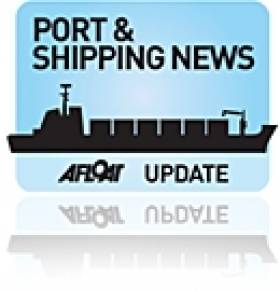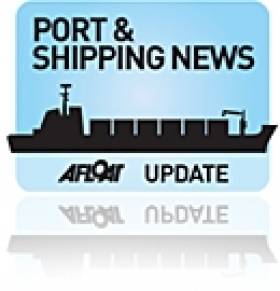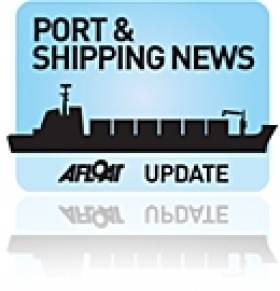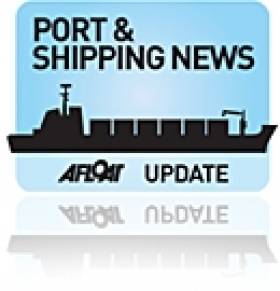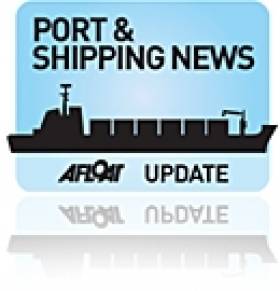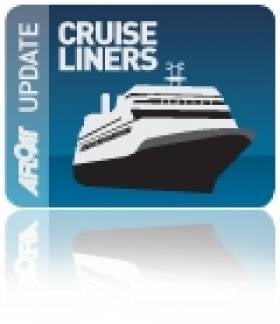Displaying items by tag: IMDO
IMDO Shipping Review: Irish-Asia Export Growth, Short-Sea Rates Levelling, German Fleet Stalling and much more…
#Ports&Shipping -The latest Weekly Shipping Market Review from the Irish Marine Development Office (IMDO) reports that Asia will be a key trading partner in future Irish export growth according to a report from HSBC Global Connections.
Research from the bank predicts that China will overtake France and Japan to become Ireland's fourth largest export destination by 2030.
In the weekly summary from the Short-Sea Shipping sector, there has been a gradual and steady decline since around the end of October last year, there appears to be signs of rates levelling over the past few weeks, with overall rates remaining stable although pressure remains downwards
Germany's merchant fleet, the third largest in the world, is experiencing stalling growth, as liquidity and capital shortages are taking their toll. The level of tonnage owned and managed by the German fleet is declining for the first time in a decade, according to German Shipowners' association VDR.
The complete IMDO Shipping Markets Review for week 9 is available as a PDF to read or download HERE.
IMDO Shipping Review: Asia Trade Grows, Scrapping Increases
#Shipping - The latest Weekly Shipping Market Review from the Irish Marine Development Office (IMDO) reports of strong Asia trade in the container market, and a growing sense of optimism among clean product tankers.
Container trade growth is expected to rise to 6.1 per cent in 2013 driven in part by strong business in Asia, which will see some modest growth at a slower pace than elsewhere throughout the year.
Demand in the tanker market is highest among smaller vessels and those handling clean products, while the crude oil market faces "another challenging year". Profits for product tankers in the Atlantic basin are up, and the fleet is looking forward to a year of growth.
The flipside of this is that more and more ships are facing a future in the scrapyard as the dry bulk market continues to stagnate and shipowners race to cut their costs.
The complete Shipping Markets Review for week 7 is available as a PDF to read or download HERE.
Paris To Host Shortsea 13 Convention
#Shipping - The European Shortsea Conference will take place for the first time in France on Thursday 14 March 2013.
Shortsea 13 at La Defense in Paris is organised by the Bureau de Promotion du Shortsea Shipping (BP2S) and SPC France jointly with other European Shortsea promotion centres - and comes just weeks after the Euromaritime exposition that kicks of tomorrow in the French capital.
The conference will cover a number of hot topics related to shorts and intermodal intra-european transport, the challenges that exist and are yet to come, and what solutions can be found.
And like last year's event, hosted in Dublin by the Irish Maritime Development Office (IMDO) and Coastlink, the convention will provide a platform to network, discuss and debate issues shared by European shipping partners.
Organisers say that contributors are still welcome to take part as speakers (e-mail [email protected] for more) or sponsors (contact [email protected] for details).
Registrations will open soon for those wishing to attend as delegates. Keep an eye on the Shortsea 13 blog or find more information on the European Shortsea Network at www.shortsea.info.
IMDO Shipping Review: Tanker Activity Dips, Cleaner Shipping in Europe
#Shipping - The latest Weekly Shipping Market Review from the Irish Marine Development Office (IMDO) reports of a strong rise in earnings in the tanker market despite a reduction in activity for December 2012.
Demand for VLCC and Aframax tankers in the Arabian Gulf experiences the steepest decline, of 37% and 45% respectively - though the market as a whole was still able to finish above the two-year average.
The dry-bulk market is also expected to exceed fleet growth in the latter half of this year, with day rate for Panamax class vessels set to increase by 12.5%.
Closer to home, plans are in the works to extend a Finnish scheme to support investment in cleaner shipping in the European Union.
Amendments to the scheme are aimed at stricter rules that will apply to marine fuel when the Sulphur Emission Control Area - comprising the English Channel, North Sea and Baltic Sea - comes into force in 2015.
The complete Shipping Markets Review for week 4 is available as a PDF to read or download HERE.
Irish Ports and Shipping Volumes Remain Steady in Third Quarter
#PORT & SHIPPING – According to the Irish Maritime Development Office (IMDO) the volume of port and shipping traffic through the Republic of Ireland remained relatively stable in the third quarter of 2012.
The latest analysis of the traffic data indicates that two of the five principal freight segments returned to growth in the third quarter, two declined and one remained unchanged.
Lift-on/lift-off (Lo/lo) trades declined 2%
Container traffic (Lo/lo) has declined by 2% during the third quarter of this year. Exports, as a subset of these figures fell for the second consecutive quarter, declining by 3% as weaker demand conditions prevailed, particularly in the Euro zone area. However, exports to other markets in Asia, South Africa, and both North and Latin America remained relatively firm. Imports declined by 1%, representing the 19th consecutive quarter of declining import volumes. However, the rate of decline in this segment has eased considerably over the course of 2012, possibly indicating the market might be finally bottoming out.
Roll-on/Roll-off (Ro/ro) traffic was unchanged at 0%
Roll-on/roll-off (ro/ro) traffic remained unchanged in the Republic of Ireland for Quarter 3 compared to the same period last year. The majority of ro/ro freight from Ireland is destined for Great Britain which continues to underperform, with leading economic indicators recording weaknesses in the retail and manufacturing sectors. Nonetheless, this is a slight improvement for this shipping market segment having recorded two consecutive quarterly declines earlier this year.
Dry bulk volumes increased by 13%
Dry bulk shipments, which make up the largest volume of traffic throughput at Irish ports, grew by 13% during the third quarter of 2012. Improved domestic demand for agricultural products contributed to the rise while exports of ores and other industrial commodities also performed well.
Tanker/Liquid bulk market increased by 9%
Liquid bulk volumes of tanker based petroleum products increased by 9% in the third quarter. This increase was primarily as a result of large volumes of crude oil being transhipped at Bantry Harbour's oil storage facilities. Excluding Bantry, volumes would have seen a decline of 8% in Quarter 3, which perhaps more accurately reflects domestic demand for petroleum products.
Break bulk volumes down by 10%
Break bulk volumes, which represent the smallest segment of the domestic market, continued to decline into Quarter 3, falling by 10% with no rise in demand for construction related materials such as steel or timber. Demand in this segment remains at historically low levels.
Outlook: The outlook for the remainder of the year appears to suggest slightly improved conditions in both import and export volumes. This is as a result of a modest pick up in seasonal trade observed during October and early November. Nonetheless, market demand conditions going forward into 2013 remain challenging. The Euro-zone officially entered into its second recession since 2009 during the third quarter this year, while continued uncertainty regarding Greece and some other member states still remains.
Globally, much focus has been on the slowdown in the Chinese and other Asian economies. The Irish growth forecast has also been revised downwards for 2013. Sentiment amongst major shipping lines and shipowners remains low. Many shipowners have to deal with a large over supply of shipping capacity in almost all sectors along with weak underlying trade demand, increased operating costs and record low charter markets.
Nine Commercial Irish Ports Recorded a Fall in Turnover of 3% in 2011
#ports – The Irish Maritime Development Office (IMDO) has released a report on its analysis of the semi-state port companies' published financial statements for the accounting period 2011. The focus of this analysis is to extrapolate key data from the annual company financial reports in order to provide a comparative review of the ports. The nine semi state port companies reviewed are all under the auspices of the Minister for Transport, Tourism and Sport.
The key findings of the report highlight that after a combined growth of 3% in turnover in 2010, the nine commercial ports recorded a fall in turnover of 3% in 2011 with turnover falling to €120m. The cost of sales remained relatively unchanged at €46.9 million. Despite the downturn last year, five of the ports managed to return profits which contributed to a total operating profit for the industry of €33 million, almost identical to 2010, with four ports recording operating losses totalling €353,640. Dublin Port generated 57% of the total share of turnover, up 3% from 2011, while it was responsible for contributing 83% of the total operating profits from the nine ports last year. Dublin and Cork, contributed a dividend to the State in the financial accounts for 2011 of 16.5million and €634,315 respectively. Galway has also announced their intention to pay a dividend in their 2012 accounts.
The latest analysis carried out by the IMDO also suggests that the majority of ports continued to reduce their costs during 2011. Labour costs fell by 8% last year, largely as a result of further reductions in the number of port employees from 429 to 389, which included a reduction of 11 employees as a result of the rationalisation of Dundalk Port Company. The total port labour force has now reduced by 26% since 2007. Eight of the nine companies recorded lower total labour operating costs in 2011.
The average return on capital employed (ROCE) increased to 2.44% last year. However only three of the nine ports provided a ROCE higher than the average, with Dublin Port highest at just over 10%.
The IMDO believes that trading conditions at Irish ports will remain challenging for the financial year 2012 with no anticipated prospects for overall growth in the principal cargo segments. The openness of the Irish economy will mean that any near to medium term recovery in traffic growth through Irish ports is likely to be dependent on a wider recovery occurring in the European and Global economy. Our forecast is that overall turnover and profits for the Irish ports will fall this year. However we still expect that the larger commercial ports will remain profitable while smaller regional ports are less likely to achieve breakeven levels this year.
A copy of the report is available to download below (pdf, 3.96 MB). The review, assumptions and opinions expressed within this report are exclusively those of the IMDO.
Exports Down as Irish Ports and Shipping Volumes Fall in 2nd Quarter
#SHIPPING VOLUMES– The following is a statement issued today by Glenn Murphy, Director of the Irish Maritime Development Office (IMDO) in which he outlines the performance of ports in the republic, where ports and shipping traffic sectors declined for the second quarter of 2012.
The latest analysis of the traffic data indicates that only one of the five principal freight segments had any growth over the second quarter while all other freight segments declined compared to the same period last year.
Freight Segments:
Lift on Lift Off Lift-on/lift-off (Lo/lo) Trades were Down -5%
Container traffic (Lo/lo) declined by 5% during the second quarter of the year. Exports a subset of these figures fell by 5% in the second quarter as weaker demand conditions prevailed in major global markets. This was the first quarterly fall for exports since the beginning of 2010. Imports in this shipping segment fell by 6% in the second quarter. This represents the 18th consecutive quarters of declining import volumes as weak underlying domestic consumption prevails. The first six months of 2012, shows that imports declined by 4% while exports declined by 2%.
Roll-on/Roll-offRoll-on/Roll-off (Ro/ro) declined by -4%
Roll-on/roll-off (ro/ro) traffic declined in the Republic of Ireland by 4% in Quarter 2. The majority of Ro/Ro freight from Ireland is destined for Great Britain. The UK economy contracted between April and June with marked declines in its construction and manufacturing sectors. The first six months of 2012, shows that Ro/ro traffic declined by 3%.
Dry bulk Dry bulk volumes declined by -6%
Dry bulk volumes through Irish ports fell 6% during the second quarter of 2012 and by 3% for the first six months of 2012 with a notable fall in coal imports and aggregates, however other significant products in this sector such as animal feed and other agricultural products continued to perform well.
Tanker Tanker/Liquid bulk market increased by +28%
Liquid bulk volumes of tanker based petroleum products increased by 28% in the second quarter. This increase was primarily as a result of large volumes of crude oil being transshipped at Bantry Harbours oil storage facilities. Excluding Bantry, volumes would have seen a decline of 8% in Quarter 2, which more accurately reflects domestic demand for petroleum products.
BreakbulkBreak bulk volumes were down by -3%
Break bulk volumes continued to decline into Quarter 2, by 3 per cent with no rise in demand for construction related materials, such as timber, steel or cement. Looking at the traffic data to mid-year shows that for the first six months break bulk traffic declined by 7%.
Outlook: The outlook for the remainder of the year is flat with no significant uplift in volume demand on the key trades expected. The continued economic uncertainty globally is also having an adverse impact on International shipping markets with several leading shipping lines downgrading their volume forecasts for 2012.
Manufacturing orders across Europe also show little signs of imminent improvement as the euro zone's debt crisis threatens some of Europe's major economies.
Going forward two other caveats also need to be taken into account, firstly the weakness of the euro against most major currencies could provide some positive advantages for Irish exporting companies over the coming months, however oil prices remain at historically high levels and any further price rises are likely to have a negative impact on both transportation and production costs.
For further information about the IMDO visit: www.imdo.ie and news reports on port and shipping click HERE.
Strong First Half 2012 Cruise Call Season to Ireland
#CRUISE LINERS – According to the Irish Maritime Development Office (IMDO), a number of calls by international cruise ships to Irish ports, many on their maiden calls to this country, have visited within the first half of 2012.
Irish Ports had confirmed visits for 202 international cruise liners this year and so far they have welcomed a broad collection of vessels including Princess Cruises 'Grand' class liner Grand Princess in January which lead to the disembarkation of an estimated 4,000 visitors to Dublin Port.
Also calling to the capital as previously reported was the $250m luxury cruise liner MSC Lirica carrying almost 3,000 passengers and Cobh during the month of August. She is due to make a repeat call to both ports this weekend, firstly to the capital and then sailing overnight to Cobh.
Over the past two years, it has been estimated that the cruise ship industry has contributed €20.3 million to the island of Ireland.
With the increase in bigger liner ships calling to this country there are clear indications that the contribution that the cruise industry is making to the Irish economy will have a significant influence on the economic opportunities for the hinterland's of Irish host ports, and could be worth a potential €60 million over the next few years.
Most recently, at the Cruise Europe Conference 2012 held at Royal Greenwich, London, Captain Michael McCarthy of the Port of Cork, was unanimously elected Chairman of Cruise Europe. Captain McCarthy is currently serving as Commercial Manager with the Port of Cork Company.
Commenting on the Irish cruise business, the newly elected chairman of Cruise Europe, Captain Michael McCarthy said: "There are many indirect economic and tourism benefits to Ireland from the cruise sector, as well as the benefit of introducing Ireland to new markets and growing business opportunities. Cruise visits help to showcase Ireland's world class shore products, destinations and highlight all that Ireland has to offer visitors."
He continued: "One of Ireland's advantages is the strategic and geographic spread of its numerous ports, many of which are in close proximity to world class tourism destinations and it is with this in mind that Ireland will be promoted with the North and Atlantic European destinations to develop thriving and 'must see' destinations".
New Ship-Management Company Launched in Cork
#PORTS & SHIPPING NEWS – The Irish Maritime Development Office (IMDO) have welcomed a newly founded ship-management company, Barry Shipping, which started operations in Cork at the end of last year.
The company headed by Corkonian Owen Barry, provides ship management, crew management, project management, training and a range of other services for the maritime industry.
Glenn Murphy, director of the IMDO said "We wish Barry Shipping well with their new venture and look forward to providing them with further strategic and network support to assist them during their continued development".
Commenting on their future strategy Barry said, "The company's aim is to provide clients with creative and profitable solutions to meet and overcome some of the unique challenges in the current climate".
Barry graduated from Cork Institute of Technology (CIT) in 1996 and started his career with BP Shipping as an Engineering Cadet. This was followed by working with leading passenger operators Irish Ferries, P&O Cruises and Dobson Fleet Management where he served as Chief Engineer and Technical Superintendent. In 2009 he returned to Cork to run operations for Fastnet Line.
For more information about the new company, visit www.barryshipping.com
In addition for details about the role of the (IMDO) which is Ireland's national dedicated development, promotional and marketing agency for the shipping services sector click HERE
Shortsea 12, European Convention
#PORTS & SHIPPING - The Irish Maritime Development Office (IMDO) and Coastlink are to jointly host Shortsea 12, The European Shortsea Convention at the Mansion House, Dublin on 24th May 2012.
This year's event sponsored by the Dublin Port Company, will bring together Europe's senior executives, representing leading Shortsea operators (bulk and unitised) shippers & buyers of transport services, port and maritime terminal operators, logistics and supply chain companies.
The convention will provide a platform to network, discuss and debate current industry issues. In addition it will focus on the key Industry issues that are informed by the industry:
• State of the Shortsea Markets.
• Views of major European Exporters and Supply Chain managers.
• Analysis of current issues facing Shortsea Ports and Shipowners
A pre-conference high-level networking event will be hosted on the evening of the 23rd of May for delegates and industry executives.
For further information about Shortsea 12 click HERE


























